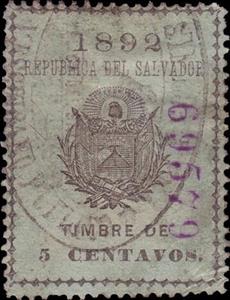Stamp: Coat of arms of El Salvador (El Salvador 1892)
Coat of arms of El Salvador (El Salvador 1892)
01 January (El Salvador ) within release Documents : 1891 issue, coat of arms on plain back goes into circulation Stamp Coat of arms of El Salvador face value 5 Salvadoran centavo
| Stamp Coat of arms of El Salvador in catalogues | |
|---|---|
| Forbin: | For: SV D21 |
Stamp is square format.
With purple control numberAlso in the issue Documents : 1891 issue, coat of arms on plain back:
- Stamp - Coat of arms of El Salvador face value 1;
- Stamp - Coat of arms of El Salvador face value 5;
- Stamp - Coat of arms of El Salvador face value 25;
Stamp Coat of arms of El Salvador it reflects the thematic directions:
A coat of arms is an heraldic visual design on an escutcheon (i.e. shield), surcoat, or tabard. The coat of arms on an escutcheon forms the central element of the full heraldic achievement which in its whole consists of shield, supporters, crest, and motto. A coat of arms is traditionally unique to an individual person, family (except in the United Kingdom), state, organisation or corporation.
A flag is a piece of fabric (most often rectangular or quadrilateral) with a distinctive design that is used as a symbol, as a signaling device, or as decoration. The term flag is also used to refer to the graphic design employed, and flags have since evolved into a general tool for rudimentary signalling and identification, especially in environments where communication is similarly challenging (such as the maritime environment where semaphore is used). National flags are patriotic symbols with varied wide-ranging interpretations, often including strong military associations due to their original and ongoing military uses. Flags are also used in messaging, advertising, or for other decorative purposes. The study of flags is known as vexillology, from the Latin word vexillum, meaning flag or banner.
A star is a luminous spheroid of plasma held together by self-gravity. The nearest star to Earth is the Sun. Many other stars are visible to the naked eye at night; their immense distances from Earth make them appear as fixed points of light. The most prominent stars have been categorised into constellations and asterisms, and many of the brightest stars have proper names. Astronomers have assembled star catalogues that identify the known stars and provide standardized stellar designations. The observable universe contains an estimated 1022 to 1024 stars. Only about 4,000 of these stars are visible to the naked eye—all within the Milky Way galaxy.
A volcano is a rupture in the crust of a planetary-mass object, such as Earth, that allows hot lava, volcanic ash, and gases to escape from a magma chamber below the surface. The process that forms volcanoes is called volcanism.




